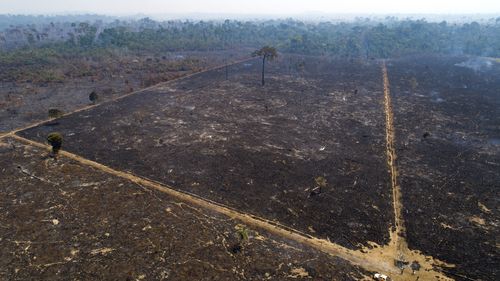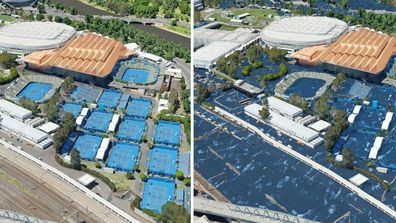But how much time – if any – does the world have to avoid the most catastrophic impacts of a changing climate?

How many years until we can’t stop climate change?
Rather than talking about whether climate change can be stopped it’s a bit more helpful to look at key “tipping points”.
“(These) include ice sheet collapse, permafrost thaw, ocean deoxygenation, ocean acidification, the die-back of the Amazon rainforest, and changes in ocean circulation, such as the slowdown of the Atlantic overturning circulation,” UNSW Climate Change Research Centre director Katrin Meissner told 9news.com.au.
“Some researchers would also argue that sea ice should be on that list.
“Per definition, a tipping point leads to an abrupt and irreversible change that is much faster than the climate trend that is forcing the change.”
So how far away are we from hitting them?
“That’s the big question we’re all trying to pin down,” Professor Matthew England from UNSW told 9news.com.au.
“In a way, that’s the biggest unknown we have.
“It’s safe to say we know these tipping points exist. What we know less about is how close to the tipping points we are.
“Some people say we’re already, for example, past a tipping point for the Greenland ice sheet.”
Similarly, a paper released last October found West Antarctic ice shelf melting could be inevitable, while overturning circulation in the Atlantic is already at its weakest in more than 1000 years and is on track to reach a tipping point, according to a different report.

“We know we’re getting closer to them as our climate changes,” England says.
“Just exactly how close is still unclear.”
One measure that most people will be familiar with is the idea of limiting warming to 1.5 degrees above pre-industrial levels – a key goal of the Paris Agreement.
While that’s happened for relatively short stretches of time in recent months, long-term average temperatures are yet to breach the threshold, although England says it’s likely only a matter of time.
“A lot of climate scientists were surprised to see just how much 2023 had warmed by,” he said.
“And we’re going to break that record again this year, I think…
“Jumping above (1.5 degrees of warming) for a few weeks at the moment just shows how close we are to breaching that guardrail.
“We’re not past it yet, but I think to say Paris is gone as a target is a reasonably safe statement, because of the trajectory we’re on with warming and also with greenhouse gas emissions not coming down.”
“In my opinion, we do not stand a chance to limit global warming to 1.5 degrees,” she says.
At what point will climate change be irreversible?
Unfortunately, climate change can’t be reversed – or at least not in any timeframe that’s helpful for present-day humanity.
“On timescales that are relevant to humans, none of the effects we see right now can be reversed, not even those that are not related to tipping points,” Meissner says.
“They can only stay the way they are or get worse.”
This is because the carbon dioxide that we’ve released into the atmosphere stays there for millenia, and efforts to supercharge that process are unproven.
“There are brilliant minds getting to work at what we call ‘negative emissions’,” England says.
“These are ways to draw down carbon dioxide. You hear about kelp forests in the ocean, planting trees is a very simple one… there’s a whole bunch of measures out there to reduce emissions.
“Unfortunately, those devices, those engineering programs to draw down carbon dioxide, the cost of them is exorbitant, and they don’t really scale.”

So what can we do to help climate change?
“We’ve got to back renewables,” England says.
“And we’re so lucky in Australia with an abundance of solar in combination with wind and battery storage.”
He says it’s crucial to not throw out climate and emissions reduction targets just because the world looks all but certain to breach 1.5 degrees of warming.
“We shouldn’t tear the Paris Agreement up, because the process there is to reduce our emissions… it’s not like we go up in half degree increments.
“We have every chance of, say, limiting global warming to 1.7 degrees. And that’s better than getting close to that two-degree threshold.”

What will happen if we do nothing to stop climate change? What will the effects be?
“Temperatures will continue to rise, oceans will continue to acidify, and climate change impacts will continue to increase drastically,” Meissner says.
“The consequences will be disastrous, first for the most vulnerable countries and populations, but eventually for everyone.”
Some of those tipping points would have a significant impact on the world.
Melting ice shelves, for example, leads to significant sea level rises. The collapse of Atlantic overturning circulation could make for more storms, and more extreme winters, heatwaves and droughts in Europe.
Back home in Australia, a warmer climate is likely to create more severe droughts, storms, bushfires and cyclones.
That’s not just going to bring a physical danger from natural disasters, but also a heightened financial burden for households and taxpayers.

“As the climate system changes, there will be costs associated with adapting to those changes” England says, pointing to the $2.8 billion earmarked by the WA government for the state’s third desalination plant as an example.
“It is going to cost us in terms of building this infrastructure to secure us against these impacts of climate change, and also with increased insurance costs.
“So it’s going to cost us, but it’s going to cost us a lot less if we reduce emissions and move towards a low carbon or net zero carbon future, because the cost of everything just goes up the longer we wait.

How sea level rises could look in global cities
“So every half-degree of extra warming means more increased extremes in weather, severe bushfire seasons, flooding rates, all these events that we’re becoming all too familiar with will just get worse over time.”







